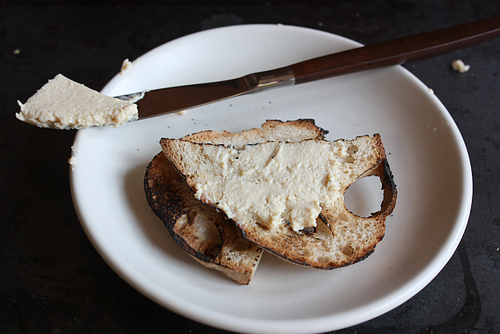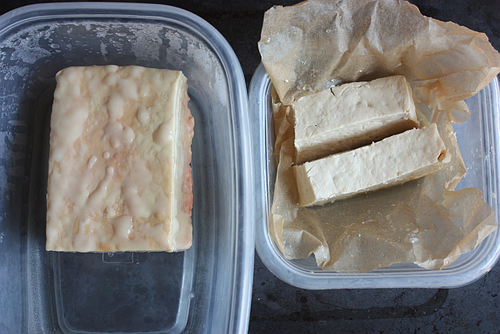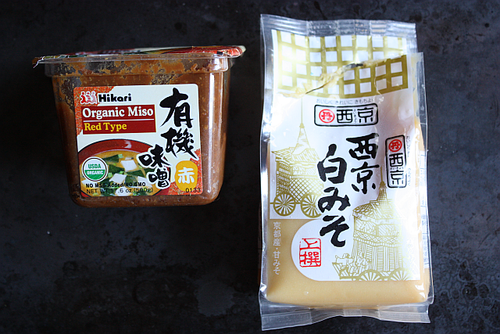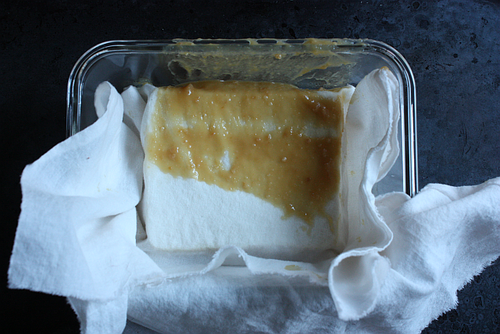
I came home on Sunday and inspected a couple of tubs of tofu that
I‘d left sitting in the fridge while I was away on the Pacific Northwest tofu tour. One contained creamy salty tofu
misozuke, an old school type of fermented tofu from Japan that I’d made about 6 weeks earlier. I smeared a piece on bread to taste. It had mellowed and matured nicely while I was traveling.
The other tub of tofu – a block of super-firm
tofu, had slimy white and orange stuff on it. I threw it out as it had clearly
gone bad. That’s the difference between tofu that’s been preserved and not. One
you want to eat and the other you discard.
A while back, I posted a Q&A
with Dang Vu, a Vietnamese-American who’d started making and selling tofu
misozuke in the Bay Area. A couple of Twitter friends suggested that I make the
stuff so I did. There’s a fermented tofu recipe in Asian Tofu (see page 41) so
I wasn’t daunted. Note that some people call tofu misozuke "vegan cheese." To me, it's just an Asian type of fermented tofu.
If you’ve had Chinese fermented tofu (fu ru in Mandarin, chao in
Vietnamese, tao hu yi in Thai), tofu
misozuke is similar, though relatively obscure in Japan. Its use seems to be
relatively limited to eating it as a nibble or spread. In Washoku,
Elizabeth Andoh suggests it as a snack food with drink. Chinese fermented tofu, on the other hand, is used as a
cooking seasoning for marinades, sauces, braises, stir-fries and roast meats.
What’s the
low-down? In a nutshell, if you salt tofu and then let it sit around, it
will break down into a creamy texture. Whereas Chinese fermented tofu sits in a
salty and rice wine brine for months, Japanese tofu misozuke is coated with
miso, sake and sugar. Without these elements, the tofu grows mold and turns
slimy – just like regular cheese does.
The idea
is this: Block tofu is basically a dairy product. It’s made from the curds
that result from coagulating soy milk, like how cheese is prepared. Let the soy or animal milk curds go bad in a
good way and you get something rather tasty.
To make tofu misozuke, I applied concepts that I learned from developing the Chinese white fermented tofu recipe in the book:
- Using firmer tofu makes prettier, sturdier
chunks but they take longer to turn creamy because the curds are more
compressed. - Waiting is the hardest part. It takes 6 to 8
weeks for the stuff to mature. - Taste on a weekly basis to monitor progress.
The stuff was burpy to me at the front end. - Ferment in the fridge for food safety’s sake.
- Tinker with the flavor. I made 2 trials and
found that going a little saltier was better. Blend your favorite misos.
The trickiest thing about this recipe is wrapping up the tofu in
cloth. The Japanese often marinate foods by wrapping it in cotton cloth and
then slathering the marinade on the outside. I used a piece voile (a thin
cotton fabric sold at fabric stores) so I could wash and reuse it. Muslin would
be a little too thick so yes, you could use a double layer cheesecloth. You
want just a thin layer of fabric between the tofu and the tofu mixture.
So I spread some miso marinade on the bottom of my container then
lined it with the fabric. Then, I put the tofu in, cover it with fabric, then the
miso.
This is a great recipe for people who like to do science experiments in the kitchen. Or, if you just want to do something cool with tofu. I suppose you could also gift this for the holidays if you get started soon.
RECIPE
Tofu
Misozuke
Yield: about 10
ounces
Ingredients
- 10 to 12 ounces (280–336 g) medium-firm or firm tofu, organic
or non-GMO preferred - ⅔ cup (7 oz, 200 g) white miso
- 1 ½ tablespoons (1 ¼ oz, 35 g) red miso
- ¼ cup sake
- 3 to 4 tablespoons mirin
Instructions
- Cut the tofu into two 1-inch-thick slabs. Place on a dry dishtowel
or paper towels and set aside to drain for 15 minutes. Pat the tofu to remove excess
moisture. - In a bowl, combine both kinds of miso with the sake and mirin.
Adjust the flavor for a salty, sweet finish. - Select a container to snugly contain the tofu in one layer. Spread
⅓ of the miso mixture on the bottom. Arrange the voile (or cheesecloth) on
top. Place the tofu on the fabric. Then fold the fabric over the tofu. Spread
the remaining miso mixture over the fabric to cover the sides and top. If needed,
fold any excess fabric over the miso mixture. - Cover the container and refrigerate for 3 or 4 days. If water
gathers in the container during this period, pour it off. Nick and taste the
tofu after this first period and it will seem really salty. Unwrap the tofu and
transfer it to another container lined with parchment, cover and refrigerate
for 5 to 8 weeks. (Discard the miso mixture and recycle the voile or discard
the cheesecloth.) - You can eat the tofu after the first 3 or 4 days of marinating but
it will mellow and transform as it sits longer. Put it in the back of the
fridge and forget about it. You can cut off bits to monitor its progress. I
found that at 6 weeks, mine was nice. I'm sure it'll be even better at 8 weeks. Enjoy as a cheese-like spread – on
bread or a cracker.
Related links:
- My Q&A with Dang Vu of Rau Om on his Tofu Misozuke
- Rau Om's recipe for tofu misozuke
- Recipe Renovator's recipes for tofu misozuke (Stephanie Weaver has variations)




















Jeanette says
I love this Andrea! I've been reading about fermented foods lately and making kimchi and other fermented foods at home. Can't wait to try this!
Andrea Nguyen says
It's really interesting, Jeanette. Let me know your thoughts.
Linda @ My Foodgasm Journal says
Whoaaaa - so interesting project. I love reading your 'science' project, this is definitely so much fun and I can't wait to share it with my mom.
Stephanie, The Recipe Renovator says
Thanks for the link Andrea!
Andrea Nguyen says
Totally interesting, Linda. After you try this out, maybe grow mold and then brine the tofu for Chinese-style fermented tofu? Seriously. 🙂
Andrea Nguyen says
My pleasure, Stephanie!
Linh-Dang says
Wow, I've been way too busy and didn't see this until now. Thanks for link, Andrea!
magdika says
Thank you so much for this wonderful post.
There's so much information out there nowadays saying that unfermented so is bad. I'm vegan ..... So this is a valuable post and recipe to me. Looking for healthy option only - the healthiest miso I found was organic unfermented yellow miso. Do you think your recipe will work with just this miso instead of both the white and red?
Thank you!
Magdika
Oni says
Hi:
Today we tasted our misozuke, after 8 weeks in the fridge. It is quite moist, has creamy goo like a melted soft brie, sort of creamy bubbles all around, a little pinkish but no other colour. Tasted very nutty creamy, not salty really. My husband can't quite describe it, he likes it but not too bowled over.
I am just happy it did not go mouldy- or at least it doesn't look like it. What does bad misozuke look/taste like anyway?
Oni.
Meagan says
Mine just stayed firm somehow. Crazy disappointed. I wonder what happened. Left it just over 6 weeks. Made three different versions (slightly). One wrapped in cheesecloth. One in Nori. One just slathered the miso on. Left in the container changing paper towels and wiping out condensation. It just started to sprout a bit a mould or I would have waisted an extra week or two. Not even a bit creamy. Almost a firmer tofu than before. So weird.
Andrea Nguyen says
That's very strange. The tofu should have naturally broken down. Did you use super-firm tofu? That's the kind sold in vacuum-sealed packaging.
Amy says
This is absolutely amazing! It's a great complement to Chinese fermented tofu in that it's in a similar umami vein but has its own delightful taste. The hardest part indeed is waiting for it to age because it truly does develop more beautiful and complex flavors the longer you can hold off. Is this technically a fermented food? I would imagine that the cultures present in unpasteurized miso would propagate into the tofu. I am going to have to keep this on a regular rotation for my food products. Its much easier to make than Chinese fermented tofu too, which is incubated with mold before it is aged in brine and seasonings. I'm so glad I found this past. Thank you for sharing a rare treat!
Andrea Nguyen says
You're so welcome, Amy! Fermentation is going on to turn the tofu into creamy deliciousness! Waiting is the hardest thing so just slide it into the back of the fridge.
S says
Andrea, do you have a replacement substance for saki? Something non alcoholic possibly? Thanks.
Andrea Nguyen says
Omit it to see what happens. I unfortunately do not know of a non-alcoholic substitute.